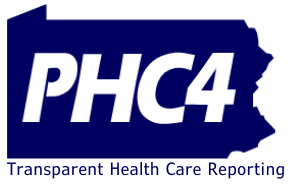Contact: Joe Martin
717-232-6787 or
HOSPITAL ADMISSION RATES FOR HEROIN OVERDOSES INCREASE MOST FOR OLDER PENNSYLVANIANS (AGE 55 AND OLDER), HISPANICS AND THOSE WITH LOWER INCOMES
Harrisburg, PA – September 12, 2018 – The hospitalization rate for Pennsylvanians age 55 and older admitted for a heroin overdose increased 35.8%, between 2016 and 2017. Hispanic residents had the highest increase at 48.8%. Lower income residents had an increase of 40.8%. There was a 12.5% increase in the rate of hospital admissions for heroin overdose among Pennsylvania residents overall.
âOpioid use is an âequal opportunity offenderâ and affects all segments of Pennsylvaniaâs population; yet, some have been hit particularly hard,â stated Joe Martin, PHC4âs Executive Director. âWhile Pennsylvania has made progress in curbing admissions for pain medication, heroin continues to be a significant challenge,â added Martin.
These results are included in a research brief released today by the Pennsylvania Health Care Cost Containment Council (PHC4). The brief is part of a series produced by PHC4 that examines opioid-related hospitalizations. This edition focuses on demographic differences among Pennsylvania residents hospitalized for opioid overdose, identifying those with the highest rates of hospitalization in 2017 as well as those with the highest rate increases between 2016 and 2017. Results for heroin overdose and pain medication overdose are reported separately.
Findings by age:
- While residents aged 55 and older had the lowest rate of hospitalization for heroin overdose in 2017 (5.3 per 100,000 residents), the rate for this age group increased 35.8% between 2016 (when the rate was 3.9) and 2017âthe highest increase among all age groups. The rate more than tripled for this age group since 2013.
- In 2017, residents aged 55 and older had the highest rate of hospitalization for overdose of pain medication at 19.8 per 100,000 residents. Between 2016 and 2017, the rate increased 8.0% for residents aged 15-34. Rates decreased for other age groups.
Findings by race/ethnicity:
- Hispanic residents had both the highest rate of hospitalization for heroin overdose (19.3 per 100,000 in 2017) and the highest rate increase (48.8%) between 2016 (when the rate was 13.0) and 2017.
- In 2017, black (non-Hispanic) residents had the highest hospitalization rate for pain medication overdose (18.5 per 100,000). Hispanic residents had the lowest rate at 9.4 per 100,000, but, as a group, had the highest rate increase (31.1%) from the 2016 rate of 7.2.
Findings by household income:
- In 2017, residents living in areas where the average household income is less than $30,000 a year had the highest rate of hospitalization for heroin overdose (40.5 per 100,000 residents) and the highest rate increase (40.8%) between 2016 and 2017.
- Lower income residents also had the highest rate of hospitalization for pain medication overdose (27.5 per 100,000 residents) and the highest rate increase (8.7%) between 2016 and 2017.
Findings by rural/urban residency:
- In 2017, residents living in urban counties had a higher rate of hospitalization for heroin overdose at 19.0 per 100,000 residents. Urban residents also had a higher rate increase (14.0%) between 2016 and 2017. However, over the longer-term (between 2000 and 2017), the rate of hospitalization for heroin overdose increased 588% for rural residents and 334% for urban residents.
- Urban residents also had a higher rate of hospitalization for overdose of pain medication (16.8 per 100,000). Rates decreased for both urban and rural residents between 2016 and 2017.
Findings by female/male:
- In 2017, male residents had a higher rate of hospitalization for heroin overdose at 24.1 per 100,000 residents. They also had a higher rate increase (13.5%) between 2016 and 2017.
- Males also had a higher rate of hospitalization for pain medication overdose at 16.8 per 100,000. The rate increased 7.8% for males between 2016 and 2017 but decreased 10.7% for females.
County-level population-based rates for the two-year period 2016 and 2017 are also included in the brief.
The brief is available on PHC4’s website at www.phc4.org. You can also link to it through social media on Facebook and Twitter.
PHC4 is an independent state agency charged with collecting, analyzing and reporting information that can be used to improve the quality and restrain the cost of health care in Pennsylvania.

